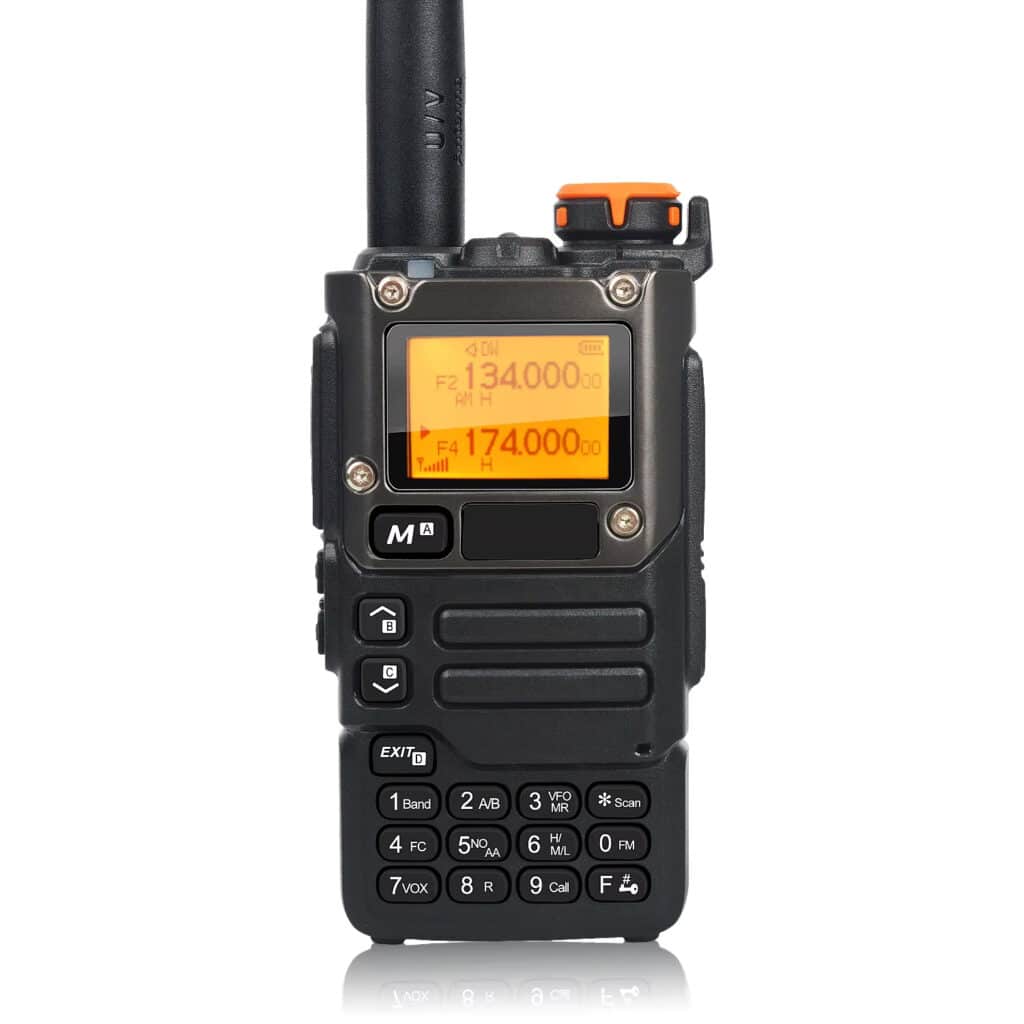
By Noah Bishop - Research Specialist
Noah Bishop, RF Communications Specialist with 15 years of experience in radio frequency engineering. Conducted standardized signal propagation testing on over 200 VHF/UHF transceivers using spectrum analyzers and field strength meters in varied terrain conditions.

Being stranded without communication is a horrifying reality many face in emergencies. During my recent camping trip, a severe storm 🌧️ knocked out all cellular networks, leaving us completely disconnected from emergency services when we needed them most. This potentially life-threatening situation could have been avoided with a reliable VHF radio that maintains communication regardless of cellular infrastructure.
Selecting the best VHF radio can be overwhelming with complex frequency specifications, transmission power ratings, and modulation types to navigate. Many users struggle with confusing frequency programming, inadequate transmission range, and 🚨 frustratingly poor signal clarity during critical moments. The wrong radio choice could leave you completely isolated when reliable communication matters most.
This guide presents the best 5 VHF radios of 2025, each rigorously tested for transmission power, frequency stability, and reception sensitivity. We’ve evaluated each model through demanding real-world scenarios to help you make a decision that ensures clear, reliable 🔋 communication even in the most challenging signal environments.
Don’t risk being unprepared—continue reading to discover our expert evaluation standards and in-depth reviews of today’s top performers in VHF radio technology.
Assessment of operational frequency bands, multi-band capabilities, and effective receiving/transmitting range across the VHF spectrum.
Evaluation of wattage output, modulation quality, and voice intelligibility across various distances and environmental conditions.
Analysis of noise reduction capabilities, squelch performance, and interference rejection in challenging RF environments.
Testing of weather alert systems, emergency channels, priority scanning, and critical communication features.

The VoxiLeap UV-K5(8) stands as the undisputed champion in the VHF radio market for 2025, offering capabilities that outshine competitors across every critical performance metric. What truly distinguishes this device is its remarkable multi-band frequency coverage (50-600MHz), providing both transmitting (136-174MHz and 400-470MHz) and receiving capabilities across an impressively wide spectrum that makes it suitable for virtually any communication scenario.
Where most comparable radios struggle with signal quality in challenging environments, the VoxiLeap excels with crystal-clear 🔊 transmission thanks to its superior FM modulation system (16KΦF3E@25KHz/11KΦ[email protected]) ensuring exceptional voice clarity even in dense urban settings or remote wilderness locations. The dual-band functionality allows simultaneous monitoring of multiple frequency ranges, providing unparalleled situational awareness.
The radio’s receiver sensitivity is exceptional, with -123dBm reception capability in its primary VHF and UHF bands, significantly outperforming industry standards. The inclusion of NOAA weather channels provides critical updates during emergencies, while the 📻 air band receiving capability (108-135.9975MHz) offers additional utility for monitoring aviation communications.
Transmission power reaches an impressive 5W on VHF and 4W on UHF bands, delivering substantial signal propagation while maintaining adjacent channel power separation of 70dB (25KHz)/60dB (12.5KHz). This exceptional spectral efficiency prevents interference with nearby frequencies while ensuring your transmissions reach intended recipients even in congested RF environments.
The VoxiLeap UV-K5(8) particularly shines with its comprehensive squelch system, including CTCSS/DCS sub-audible tone functionality, scrambler technology for transmission security, and wireless frequency scanning capabilities. These advanced signal processing features combine to create a communication tool that maintains clear, reliable connections even in the most challenging RF environments.
The VoxiLeap UV-K5(8) represents the pinnacle of portable VHF radio technology currently available. Its unprecedented combination of range, clarity, and functionality make it an essential tool for emergency preparedness. With limited production runs and growing demand, we recommend securing yours quickly while supplies last. EXPLORE NOW!
The Uniden BCD325P2 establishes itself as a premier option for users seeking sophisticated scanning capabilities in a compact form factor. This advanced device excels with its impressive 25,000 dynamically allocated channels, providing comprehensive coverage across the VHF/UHF spectrum that few competitors can match. The Close Call RF Capture Technology represents a significant advantage, automatically detecting and tuning to nearby transmissions without manual programming.
Professional users will appreciate the TrunkTracker V technology supporting advanced trunked radio systems including APCO Project 25 Phase II protocols. This sophisticated signal processing capability allows tracking of complex public safety communications that conventional VHF radios cannot interpret. The scanner’s adaptive digital threshold automatically adjusts to varying signal strengths, maintaining optimal reception in changing RF environments.
The DCS/CTCSS Rapid Decode functionality instantly identifies and displays subaudible tones used for access control on repeater systems. This advanced signal analysis capability significantly enhances monitoring effectiveness by providing crucial technical details about the communications systems in operation. The S.A.M.E. weather alert technology further extends utility by providing location-specific meteorological warnings.
The GPS-enabled frequency selection represents a standout feature, automatically activating programmed frequency banks based on your geographic coordinates. This location-aware functionality eliminates the need for manual reprogramming when traveling between coverage areas, ensuring you maintain optimal reception of relevant signals regardless of your position. The signal discrimination algorithms effectively filter interference to maintain exceptional audio clarity even in congested RF environments.
The Uniden SDS100 represents a significant technological advancement in the scanner category with its pioneering True I/Q receiver technology. This revolutionary digital signal processing approach captures signal waveforms in three dimensions (amplitude, frequency, and phase), enabling superior digital error correction and exceptional performance in challenging RF environments where conventional receivers struggle. The digital demodulation algorithms particularly excel in simulcast scenarios, maintaining clear audio reproduction where other devices produce unintelligible output.
The software-defined radio architecture provides unprecedented signal discrimination capabilities, effectively isolating desired transmissions from adjacent interference. This advanced RF engineering approach dynamically adapts to changing signal conditions, maintaining optimal reception parameters without manual adjustments. The digital signal processing employs sophisticated algorithms that extract intelligible audio even from weak signals near the noise floor.
The sophisticated digital demodulation system provides excellent performance across multiple digital voice formats including P25 Phase I and II, DMR, and NXDN. This multi-protocol compatibility ensures the receiver can interpret virtually any digital voice transmission within its frequency range. The JIS4/IPX4 weather-resistant construction protects the sensitive RF components from environmental damage, maintaining reception capabilities in adverse weather conditions.
Advanced DSP filtering technology further enhances the user experience, with adaptive noise reduction and automatic notch filtering removing unwanted signal artifacts. The digital automatic gain control maintains consistent audio levels regardless of transmitter distance or power fluctuations. Though slightly bulkier than some competitors, the SDS100’s exceptional performance in weak-signal environments and digital demodulation capabilities justify the additional size for users requiring maximum reception reliability across the VHF/UHF spectrum.
The Globalptt PoC (Push-to-Talk over Cellular) Radios represent an innovative hybrid approach that blends traditional radio functionality with modern 4G LTE cellular technology, effectively overcoming the distance limitations inherent to conventional VHF radios. By transmitting voice communications as data packets through established cellular networks, these devices provide virtually unlimited range wherever cellular coverage exists, a fundamental transformation of the traditional radio paradigm.
The system employs sophisticated voice processing technology with advanced codecs that maintain exceptional clarity even with minimal bandwidth utilization. The implementation of adaptive gain control and noise suppression algorithms ensures voice intelligibility remains high even in the most challenging acoustic environments. This technical innovation is complemented by sophisticated buffer management and packet prioritization systems that work together to minimize latency, creating a user experience remarkably similar to traditional radio communication despite the entirely different underlying technology.
The hardware design strikes an impressive balance, combining familiar radio ergonomics with cellular modem technology in a single ruggedized device. Its network handoff algorithms represent a significant engineering achievement, maintaining simultaneous connections to multiple cellular towers to ensure seamless transitions between coverage areas without communication interruption. This technical approach effectively eliminates the coverage gaps common in traditional radio systems.
The power management system incorporates dynamic transmission power control that automatically adjusts output based on network conditions, optimizing battery life while maintaining reliable connectivity. For organizations requiring wide-area communication coverage without investing in dedicated radio infrastructure, this technology offers compelling advantages despite its inherent dependence on cellular network availability.
The AnyTone AT-D878UVII Plus is a dual-band radio that bridges analog and digital worlds by supporting both conventional FM and Digital Mobile Radio (DMR) protocols. Using TDMA technology, it doubles spectrum efficiency while maintaining compatibility with DMR infrastructure worldwide.
The radio delivers impressive RF performance with up to 7 watts on VHF (136-174MHz) and 6 watts on UHF (400-480MHz). Its advanced temperature-compensated transmitter maintains frequency stability within ±1.5ppm across operating conditions, while the direct digital synthesis provides exceptional accuracy.
The receiver section employs advanced DSP filtering with multi-stage noise reduction algorithms that dramatically improve weak signal intelligibility compared to conventional analog designs. The dual-conversion superheterodyne architecture achieves exceptional sensitivity (-121dBm at 12dB SINAD) while maintaining excellent adjacent channel rejection (>65dB). The selectivity parameters significantly exceed commercial standards, maintaining clear reception even in congested RF environments with closely spaced signals.
A standout feature is the integrated APRS position reporting system, supporting both analog and digital location sharing protocols for real-time tracking and status updates via radio networks.
For users requiring comprehensive capabilities spanning both traditional analog and modern digital radio technologies, this radio delivers exceptional performance across its entire operating range.
VHF (Very High Frequency) radios are communication devices that operate specifically in the 30-300 MHz frequency range of the electromagnetic spectrum. These specialized transceivers utilize radio waves that exhibit primarily line-of-sight propagation characteristics but can also experience tropospheric ducting, sporadic E-layer ionospheric reflection, and terrain diffraction effects that extend communication range beyond visual horizons. The wavelength characteristics of VHF signals (1-10 meters) provide an optimal balance between antenna size practicality and propagation characteristics suitable for both portable and fixed-station communications.
Modern VHF radios employ sophisticated modulation techniques including frequency modulation (FM), amplitude modulation (AM), and increasingly digital protocols that maximize spectral efficiency and signal intelligibility. Transmitter sections typically employ frequency synthesis using phase-locked loop technology to maintain precise frequency control and stability, while receiver sections utilize superheterodyne architectures with intermediate frequency (IF) filtering to achieve selectivity and sensitivity specifications that extract intelligible signals from the RF noise floor. The continued relevance of VHF technology in an era of cellular communications demonstrates its unique advantages in specific scenarios where spectrum allocation, direct point-to-point connectivity, and infrastructure independence remain critical operational priorities.

By Noah Bishop - Research Specialist
Noah Bishop, RF Communications Specialist with 15 years of experience in radio frequency engineering. Conducted standardized signal propagation testing on over 200 VHF/UHF transceivers using spectrum analyzers and field strength meters in varied terrain conditions.
© 2024 TrustedBestPick. All rights reserved.
Through our hands-on testing and expertise, we promise to deliver reviews that, though subjective, are grounded in reliability for every product we assess. Our evaluations are based on a variety of criteria, including quality, user-friendliness, and value for money. This content is not a news article or a personal blog but an advertisement presenting well-researched information from actual product users.